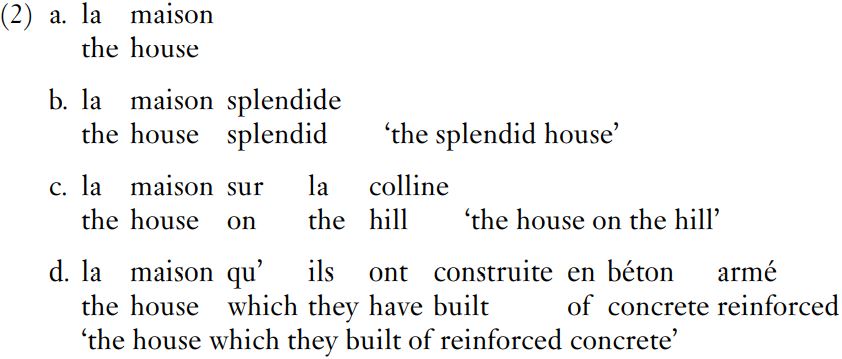
Constituent structure
 المؤلف:
Jim Miller
المؤلف:
Jim Miller
 المصدر:
An Introduction to English Syntax
المصدر:
An Introduction to English Syntax
 الجزء والصفحة:
11-1
الجزء والصفحة:
11-1
 28-1-2022
28-1-2022
 1556
1556
Constituent structure
Heads, modifiers and arrangements of words
We discussed the relations between heads and modifiers and at the end , labelled these relations ‘dependencies’. Dependencies are central to syntax. To make sense of a clause or sentence in written language or of a series of clauses in spontaneous speech, we have to pick out each head and the words that modify it. This task is made easier by the organization of words into phrases and clauses. Speakers and writers produce words and phrases one after the other. (It does not matter whether the writer sets out words from left to right, as in English texts, or right to left, as in Arabic texts.) Heads and modifiers tend to occur next to each other. For instance, in English, nouns can be modified by various types of words and phrases – adjectives, prepositional phrases and relative clauses, not to mention words such as a, the, this and some. Examples are given in (1)

In (1a), house is modified by the definite article the; in (1b) it is modified by the definite article and by the adjective splendid. The definite article, the indefinite article a and demonstratives such as this and that precede their head noun, but certain modifiers follow their head noun. Examples are the prepositional phrase on the hilltop in (1c) and the relative clause which they built out of reinforced concrete in (1d).
In noun phrases in some other languages, the order of head and modifiers follows a stricter pattern, with all modifiers either preceding or following the head. In French, for example, most adjectives and all prepositional phrases and relative clauses follow the noun, although the definite and indefinite articles precede it. This is demonstrated in (2).

The adjective splendid, the prepositional phrase sur la colline and the relative clause qu’ils ont construite en béton armé all follow the head noun. At this point, we come up against one of the interesting (or annoying) facts of French and indeed of all human languages: most patterns have exceptions. In French, a small number of adjectives precede their head noun, as in une jolie ville (a pretty town) and un jeune étudiant (a young student), but the large majority of adjectives follow their head noun.
Returning to English, we see that in certain declarative clauses the modifiers of prepositions follow their head preposition. Example (3a) shows the typical pattern, with the preposition into followed by the kitchen; (3b) shows an impossible example, with into at the beginning of the clause and the kitchen at the end; and (3c) shows the correct structure.

In some other English clauses, the noun-phrase modifier of a preposition can be separated from its head preposition. Example (4a) is the typical way of questioning room in (3a). In it, which room is at the front of the clause, and into is ‘stranded’ at the end of the clause. Example (4b) is also acceptable but is mainly used in formal writing.

We can note in passing that similar stranding is found in clauses introduced by which or who. In formal writing, a preposition plus which/who turns up at the front of the clause, as in the room into which Jeeves shimmered. In informal writing and in informal speech, the preposition is left behind at the end of the clause, as in the room which Jeeves shimmered into.
Verbs can be modified by a number of items, as we have seen in Example (5) shows the order of modifiers in a neutral clause, that is, a clause in which no particular word or phrase is emphasized.

Barbara, the subject noun phrase, precedes the verb, but the other modifiers follow it – the noun phrase (direct object) the results, the prepositional phrase (oblique object) to Alan and the prepositional phrase (adverb of time) on Tuesday. Typically, the subject and the direct object are immediately next to the verb, the subject preceding it, the direct object following it. In (5), the subject Barbara and the direct object the results are next to the verb. In other languages, the verbs and modifiers are arranged in patterns that put all the modifiers either before or after the verb. In written Turkish, for instance, the order in neutral clauses is that the verb comes last, preceded by all the modifiers.
 الاكثر قراءة في Syntax
الاكثر قراءة في Syntax
 اخر الاخبار
اخر الاخبار
اخبار العتبة العباسية المقدسة


